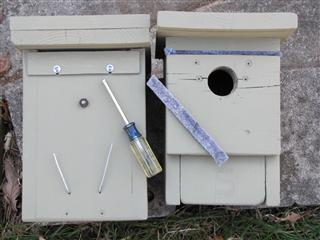

In 1986, I used the coin-toss method to determine which boxes in Delaware State Park would be winterized, and which ones would be left “open” in a controlled scientific study that revealed that as the winter progressed, wintering bluebirds learned to roost in winterized boxes rather than ones that remained ventilated. To show this, at the end of each month from November through March, I collected and weighed fecal deposits and seed packets regurgitated from bluebird gizzards. I found that bluebirds roost in a few boxes in December, but most roosting occurs in January and February. While winterizing nestboxes increases the chances that roosting birds will survive, food availability is also a huge factor that determines survivability, and “spring cleaning” reveals how well bluebirds endured the trials of winter.
In early March, I start to prepare my trails for the upcoming nesting season, and I want everything ready by March 15. For example, I return 102 nestboxes and their predator (raccoon) baffles to two Tree Swallow nestbox grids on the Delaware Wildlife Area. I also add fresh chassis grease to poles in Delaware State Park and other locations, and I reopen ventilation slots above the front panels. I reopen the back vent in late May. I start to gauge the severity of the previous winter when I clean debris from nest chambers during spring cleaning. By 11 March 2010, I had salvaged 20 winter-killed bluebirds for the Ohio Wesleyan Zoology Museum. One bird wore a leg band that my class of seven middle school students from the OWjL Academic Camp had attached on 10 June 2008. On 3 March 2010, I found the lone, dead male in a nestbox 230 yards from where it grew up with four siblings. I can tell future classes about this find along with the assumption that the bird had fathered families of its own during the 2009 season.

The winter’s death toll was expressed in my annual mid-May nest count. I counted 36 active nests in my data book that represented 7.7% fewer nests than 39 nests counted in 2009 at the same locations. The 2010 season progressed as bluebirds attempted 73 nests with eggs and 60 (82.2%) families successfully produced an average of 3.95 fledglings per nest. Of 13 failures, House Wrens left no doubt at five nests where they dropped punctured eggs in front of boxes before adding sticks to cover the usurped bluebird nests. Three nests failed for unknown reasons but hawk predation is always a possibility since Cooper and Sharp-shined hawks are common. Sometimes, if a monitor takes time to “think like a hawk,” they will move a nestbox away from a tree or other structure that hides a hawk’s sneaky approach to pluck an unsuspecting bluebird from its perch. Tree Swallows, House Sparrows, an herbicide application, a mower collision with a nestbox’s pipe mount, and competition from another bluebird account for one bluebird nest failure each.
In 2000, I decided to identify the three egg-laying periods within the bluebird nesting season in Central Ohio. I examined all records going back to 1968 and found 31 nestboxes that had housed three successful bluebird nests during the same season. The data showed first-eggs from first nests appeared before May 15. Eggs laid between May 16 and July 5 represented the second nesting period, and first eggs deposited on July 6 and later made up the third egg laying period. Using these values, I examined sixty successful nests in 2010 and found that 34 (56.7%) were started during the first period, 24 (40%) in the second, and only two (3.3%) started after July 6. In habitats where vegetation is mowed by machines or grazing animals throughout the nesting season, the first and second nestings for bluebirds are fairly equal, whereas the third nesting period can represent zero to 15-percent of a season’s nests, depending on availability of insects as determined by weather and other factors. Summer droughts usually result in poor nesting conditions and the third nesting period might be absent. On the other hand, any combination of weather conditions that supports healthy insect populations will support a prolific nesting season for bluebirds.
When I look at 29 successful nests in DSP in 2010, I find that 16 nests were successful in the earliest nesting period, 12 in the second, and only one nest produced a first egg after July 6. There are mowed lawns in the park, but many bluebirds nest where boxes stand in grasslands that are brush-hogged only once in the late fall after the nesting season. I am very thankful that the park supports the effort to promote nesting bluebirds by trimming large areas around my boxes to keep the habitat from succeeding back into a forest. Once spring arrives, the grasslands start to grow taller to produce a profusion of colorful wildflowers that support healthy populations of butterflies and moths that have won many fans that stalk both flowers and butterflies with binoculars and field guides in hand. The patches of grasslands also attract “after supper” campers and park visitors wishing to see grazing deer that appear at dusk.

For several years, a new bluebird-friendly activity, disc golf, has been active in the park. The new 20-basket course is free to the public and covers a large area near the park’s marina, then surrounds the ice-skating pond and proceeds to cut through two woodlands leading to include two picnic areas. The Frisbee sport is very popular and requires that the course be mowed, making perfect bluebird habitats in the process. Also, a second disc golf course is being developed in the north end of the park to serve visitors and the camping public that rent the park’s popular campsites that number 212. I guarantee that bluebirds will also enjoy their new mowed habitats, and I’ll make sure they have proper nesting sites for their families. Happy Bluebirding!
